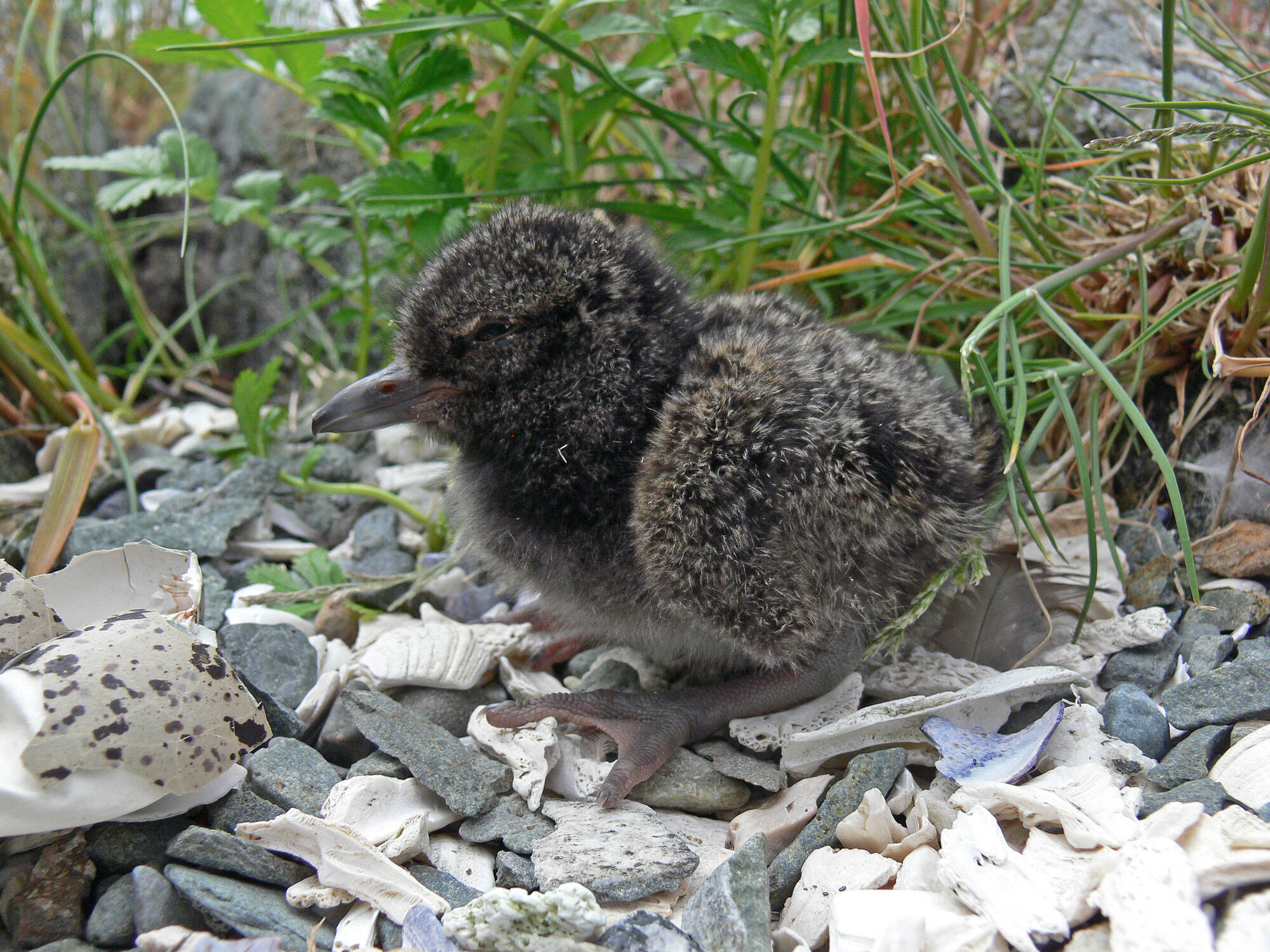At the mouth of Cowee Creek, sometime in mid-June, we’d found a vigilant pair of black oystercatchers, presumably with a nest nearby. A couple of weeks later, a small group of hikers stopped at the same spot and quickly noted that the adult oystercatchers were tending two tiny, downy chicks. The chicks had hatched quite recently; their legs and especially their bills were still very short (it would be impossible to fit an adult-size bill inside an egg). One adult guarded them closely while the other made short forays down the beach for food.
Black oystercatchers are beach-nesters; both male and female construct the nest, which is usually made of rock and shell fragments. There may be one to three eggs per clutch, incubated for about four weeks by both parents. Eggs are reported to be tolerant of flooding by high tides. The chicks can walk and swim well three days after hatching; after about five days, they start to peck at possible food items. Very young chicks are fed mostly by the male, while the female broods or guards them. Later, when chicks can follow adults to feeding sites, the female takes a more active role in feeding them. Young ones may begin to forage for themselves at about ten days, but they are just learning, taking fewer and poorer items than the adults. They gain weight quickly, but elongation of legs and bills takes longer. Even at seven weeks, chicks get much of their food from the parents, mostly marine molluscs, the large ones cut up into conveniently small pieces. They can fly, then, but in general they are not fully skilled at foraging until they are about three years old. Human disturbance can lead to prolonged incubation and fledgling times.
The trail down to Cowee Meadow provided a nice surprise—a small, yellowish-pink, peculiar-looking plant with no green color at all. This plant is called pinesap, and we don’t see it very often. Without green pigments, it is not capable of photosynthesis and making its own nutrition.
It is indirectly parasitic, tapping into the mutualistic mycorrhizal fungi that connect many green plants and carry nutrients from one to another. Connections to those nutrient-transporting fungi turn out to be essential for growth and flowering, and even seed germination of pinesap. The plant is subterranean except for the inflorescence, which pushes its way up above ground. The flowers contain nectar, and bumblebees are thought to be the main pollinators (although there may be some self-pollination too). At first, the flowers are pendant, but they tilt upward when the seed capsule is mature, thus facilitating seed dispersal.
By the end of June, the herbaceous vegetation in many meadows was decorated with the foam ‘houses’ of spittlebugs. Adult spittlebugs (aka froghoppers) can fly as well as hop, and they forage by sucking sap from the fluid-conducting tissues of plants. Stealing sap from plants can reduce the health and reproductive output of the plant, so gardeners and farmers don’t like spittlebugs. The bugs are also known to transmit certain diseases from plant to plant.
There are many species of spittlebug; the best-studied species lays eggs in plant tissues in late summer and fall; the overwintering eggs hatch in spring. The larvae (called nymphs) are sap-suckers too.
They disperse from the hatching site, and once they get to a good feeding spot, they tend to stay put, molting several times as they grow inside that foam ‘house’. They produce the foam by mixing air and excess fluid from the gut with secretions (from the end of the abdomen) that stabilize the bubbles. The foam helps protect them from predators and parasites, perhaps various micro-organisms, temperature extremes, and desiccation. Sometimes several nymphs share a foam ‘house’.
Sap is not very nutritious, but spittlebugs (and many other sap-feeding insects) have help: inside certain abdominal cells are very specialized symbiotic bacteria that provide amino acids and vitamins that are used by the host insect for growth and maintenance. These helpful bacteria are apparently passed from mothers to offspring.
• Mary F. Willson is a retired professor of ecology. “On the Trails” appears every Wednesday in the Juneau Empire.

